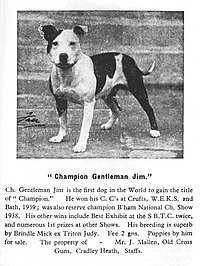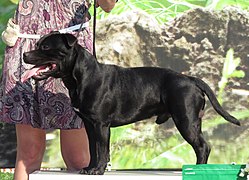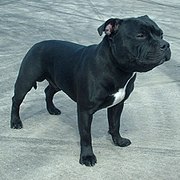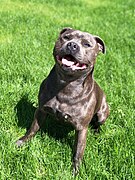This is an old revision of this page, as edited by BlueMoonlet (talk | contribs) at 03:44, 21 March 2019 (This material has been here for years. By all means discuss on the Talk page if you want to make a change.). The present address (URL) is a permanent link to this revision, which may differ significantly from the current revision.
Revision as of 03:44, 21 March 2019 by BlueMoonlet (talk | contribs) (This material has been here for years. By all means discuss on the Talk page if you want to make a change.)(diff) ← Previous revision | Latest revision (diff) | Newer revision → (diff)Dog breed
| Staffordshire Bull Terrier | |||||||||||||||||||||||
|---|---|---|---|---|---|---|---|---|---|---|---|---|---|---|---|---|---|---|---|---|---|---|---|
 | |||||||||||||||||||||||
| Common nicknames | Stafford & Staffie | ||||||||||||||||||||||
| Origin | England | ||||||||||||||||||||||
| Foundation stock | Black and Tan Terrier Old English Bulldog Bull and Terrier | ||||||||||||||||||||||
| |||||||||||||||||||||||
| |||||||||||||||||||||||
| Dog (domestic dog) | |||||||||||||||||||||||
The Staffordshire Bull Terrier is a small to medium sized, short-coated breed of terrier from England. It may be considered to be within the pit bull type. The Staffordshire Bull Terrier descends from purpose bred 19th century dog fighting and rat baiting dogs, but throughout the 20th and 21st centuries it has become an extremely popular companion dog.
Description
The Staffordshire Bull Terrier is a stocky, muscular and unusually strong, small to medium sized dog that stands 14 to 16 inches (36 to 41 cm) at the shoulder, the dogs weigh 29 to 37 pounds (13 to 17 kg) and the bitches 24 to 34 pounds (11 to 15 kg). It has a broad chest, strong shoulders, well boned wide set legs, a medium length tail that is carried low and a broad head with a short muzzle; its ears fold over at the tips and are not cropped.
The Staffordshire Bull Terrier’s coat is short, stiff and close, it be can red, fawn, white, black or blue, or any one of these colours with white, any shade of brindle or any shade of brindle with white.
Temperament
The Staffordshire Bull Terrier is considered a loyal, devoted, tenacious and particularly affectionate breed of dog, it is one of the only dog breeds recommended by the Kennel Club as suitable to be around children. The Staffordshire Bull Terrier has a reputation for pugnaciousness, when challenged by other dogs it is generally known to not back away from a fight, possibly due to its dog fighting ancestry it can be agressive to other dogs if not properly socialised at a young age.
Health
The Staffordshire Bull Terrier is generally a healthy and robust dog breed, the Kennel Club mandates that all Staffordshire Bull Terriers used for breeding must have visual eye testing as well as DNA testing for hereditary cataracts and L-2-hydroxyglutaric aciduria, they also recommend DHA testing be conducted for primary hyperparathyroidism.
History

There are two theories about the development of the Staffordshire Bull Terrier. The first and more widely held is that the Staffordshire Bull Terrier, like the Bull Terrier, descends from the Bull and Terrier, a type of dog developed in United Kingdom in the early–19 century for the blood sports of dog fighting and rat baiting. The crossbred Bull and Terrier was created by crossing the ferocious, thickly muscled Old English Bulldog with the agile, lithe, feisty Black and Tan Terrier. The aggressive Old English Bulldog, which were bred for bear and bull baiting, was often also pitted against its own kind in organised dog fights, but it was found that lighter, faster dogs were better suited to dog fighting than the heavier Bulldog. To produce a lighter, faster more agile dog which retained the courage and tenacity of the Bulldog, outcrosses from local terriers were tried, and ultimately found to be successful.

The second less widely held theory, is that the Old English Bulldog was not crossed with any terriers, but that the Staffordshire Bull Terrier is the direct descendant of the early Bulldog, selectively bred for smaller size and a more athletic build. The evidence for this theory is the distinct similarity in appearance of the modern Staffordshire Bull Terrier with Old English Bulldogs in paintings from the period.
The Cruelty to Animals Act 1835 outlawed bull and bear baiting as well as organised dog fighting. The passing of this act effectively stopped all baiting of bulls and bears within the United Kingdom as both required large arenas and so were relatively easy for authorities to police, illegal dog fighting on the other hard remained prevalent for some time, as it was easier to conduct in basements and other concealed locations. It was the Protection of Animals Act 1911 that effectively ended organised dog fights within Britain.

In the mid–19th century, James Hinks started crossing Bull and Terriers with English White Terriers to give a cleaner appearance with better legs and nicer head, later Dalmatian and Collie blood was added, these dogs became the Bull Terrier.
Devotees of the original Bull and Terrier type, predominantly located in the Black Country, maintained the original bloodlines and appearance. The name "Staffordshire Bull Terrier" did not appear until 1930 when it began to appear in advertisements for dogs of the type. Throughout 1932 and 1933 attempts were made to gain Kennel Club recognition by pioneering breeder Joseph Dunn, in early 1935 the very first show was held on the blowing green of the Conservative Club at Cradley Heath, in May the Kennel Club approved the name "Staffordshire Bull Terrier" (the first name requested, "Original Bull Terrier", was rejected by the Kennel Club). In June 1935 the Staffordshire Bull Terrier Club was formed in a meeting at the Old Cross Guns pub in Cradley Heath, that same day the breed standards were approved, further shows were held that year. Other pivotal pioneering breeders involved in the breed’s recognition were Joe Mallen and actor Tom Walls.
Modern breed
Popularity
The Staffordshire Bull Terrier is one of the most popular dog breeds in the United Kingdom, Australia, France and New Zealand. In 2019, ITV’s Britain's favourite dogs declared the Staffordshire Bull Terrier to be the most popular dog breed in Britain.
Possibly due to its popularity, within the United Kingdom the Staffordshire Bull Terrier has suffered from over-breeding, in 2013 the breed accounted for more than a third of the dogs that passed through the doors of Battersea Dogs & Cats Home. The Staffordshire Bull Terrier is often associated with chav culture and the breed sometimes attracts the negative connotations associated with that.
Breed-specific legislation
Main article: Breed-specific legislationA number of federal and municipal governments around the world have placed restrictions on the ownership of Staffordshire Bull Terriers, within the United States they are classified as pit bull type dogs.
Within the United Kingdom, Australia and New Zealand, the Staffordshire Bull Terrier is not restricted by any breed-specific legigisltion. In 2018 PETA lobbied the British Parliament to have the Staffordshire Bull Terrier added to the list of dog breeds covered by the Dangerous Dogs Act 1991 but the idea was rejected by parliament, the RSPCA, the Kennel Club, Dogs Trust, Blue Cross and the Battersea Dogs & Cats Home all objected to the proposed ban.
In the United Kingdom American Pit Bull Terriers are sometimes advertised as "Irish" Staffordshire Bull Terriers in an attempt to circumvent the Dangerous Dogs Act.
Notable animals
- Jock – a Staffordshire Bull Terrier cross, subject of Sir Percy FitzPatrick’s book Jock of the Bushveld.
- Cooper – a Staffordshire Bull Terrier adopted in March 2018 by the Staffordshire Police for training as a police dog, the first of this breed in the UK.
Gallery
References
- ^ The Kennel Club, "Staffordshire Bull Terrier: breed standard", thekennelclub.org.uk, retrieved 17 March 2019.
- ^ The Kennel Club, "Staffordshire Bull Terrier: description", thekennelclub.org.uk, retrieved 17 March 2019.
- "Staffordshire Bull Terriers - Dogs and puppies - RSPCA". Retrieved 22 November 2018.
- Dias v. City & County of Denver, 567 F.3d 1169, 1173 (10th Cir. Colo. 2009). "Pit Bull Law and Legal Definition". Retrieved 22 August 2018.
A "pit bull" is defined as any dog that is an American Pit Bull Terrier, American Staffordshire Terrier, Staffordshire Bull Terrier, or any dog displaying the majority of physical traits of any one (1) or more of the above breeds
{{cite web}}: CS1 maint: multiple names: authors list (link) CS1 maint: numeric names: authors list (link) - "Breed Information Centre – Staffordshire Bull Terrier". The Kennel Club. Retrieved 13 November 2014.
- Merriam-Webster. "Pit bull". Retrieved 26 October 2015.
a dog... of any of several breeds... that was developed and is now often trained for fighting and is noted for strength and stamina
- ASPCA. "The Truth About Pit Bulls". Retrieved 26 October 2015.
The term 'pit bull' is often misunderstood, because it does not apply to just one breed of dog.
- ^ Dr Bruce Fogle, The encyclopedia of the dog, New York: DK Publishing, 2009, ISBN 978-0-7566-6004-8.
- ^ Derek Hall, The ultimate guide to dog breeds: a useful means of identifying the dog breeds of the world and how to care for them, Buntingford: Regency House Publishing Ltd., 2016, ISBN 978-0-7858-3441-0.
- Encyclopedia Britannica, "Staffordshire bull terrier", britannica.com, retrieved 18 March 2018.
- ^ Lauren Potts, "Staffordshire bull terriers: A question of class?", bbc.com/news/, published 24 January 2015.
- The Kennel Club, "Staffordshire Bull Terrier: health information", thekennelclub.org.uk, retrieved 19 March 2019.
- ^ James Beaufoy, Staffordshire Bull Terriers: a practical guide for owners and breeders, Ramsbury, Wiltshire: The Crowood Press Ltd., 2016, ISBN 9781785000973.
- ^ David Hancock, Sporting terriers: their form, their function and their future, Ramsbury, Wiltshire: The Crowood Press Ltd., 2009, ISBN 978-0-7566-6004-8.
- Michael Worboys, Julie-Marie Strange & Neil Pemberton, The invention of the modern dog: breed and blood in Victorian Britain, Baltimore: Johns Hopkins University Press, 2018, ISBN 9781421426587.
- news.com.au, "Here’s a list of the most popular dog breeds in Australia in 2017", news.com.au, published 2 February 2017.
- Société Centrale Canine, "Le chien de race en 2018 : Bousculades dans le Top 20 du LOF", centrale-canine.fr, published 12 February 2019.
- The New Zealand Herald, "The most popular dogs in New Zealand", nzherald.co.nz, published 22 May 2017.
- Katie Avis-Riordan, "TV show Britain's Favourite Dogs names our top 100 most beloved dog breeds", countryliving.com, retrieved 17 March 2019.
- ASPCA, "Breed-Specific Legislation", aspca.org, retrieved 19 March 2019.
- Stuart Winter, "Staffie ban: Britain’s much loved terrier will NOT be outlawed, says minister", express.co.uk, published 18 July 2018.
- Daniel Foggo and Adam Lusher, "Trade in 'Irish' pit bulls flouts dog law", telegraph.co.uk, published 2 June 2002. (Archived 3 August 2018).
- Sir Percy FitzPatrick, Jock of the Bushveld, London: Longmans & Co., 1907.
- Georgia Diebelius, "Dog rescued from streets becomes one of UK’s first police Staffies", metro.co.uk, published 19 November 2018.
External links
| Dogs originating in the United Kingdom | |||||||
|---|---|---|---|---|---|---|---|
| Hounds | |||||||
| Gun dogs | |||||||
| Terriers |
| ||||||
| Herding dogs | |||||||
| Other | |||||||
| Extinct |
| ||||||
| |||||||









